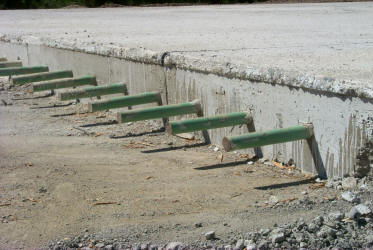In the world of construction, the integrity of a structure often hinges on the strength and stability of its foundations. One essential element that plays a critical role in fortifying concrete structures is the use of dowel connections. This article explores the significance of dowel concrete connections, their applications, and the benefits they bring to the longevity and stability of diverse construction projects.
Understanding Dowel Concrete Connections:
Dowel concrete connections are engineered systems that involve the use of cylindrical rods, commonly referred to as dowel bars, to connect adjacent concrete elements. These connections strategically placed to transfer loads, accommodate movement, and enhance the overall structural performance of concrete structures. Dowel bars are typically made of materials such as steel or fiberglass and are installed in a manner that allows controlled movement between concrete sections.
Applications of Dowel Concrete Connections:
- Jointed Plain Concrete Pavements (JPCP): Doweles concrete connections are frequently employed in the construction of Jointed Plain Concrete Pavements. In highway and airport runway projects, dowel bars installed at transverse joints to facilitate load transfer between slabs, minimizing differential settlement and preventing the development of cracks.
- Bridge Construction: In bridge construction, dowel bars play a crucial role in connecting adjacent precast or cast-in-place concrete components. These bars help distribute loads evenly, reducing stress concentrations and enhancing the overall stability and durability of the bridge structure.
- Industrial Floors: Doweles concrete connections find extensive use in the construction of industrial floors and warehouses. By incorporating dowel bars at construction joints, these floors can accommodate the significant loads imposed by heavy machinery and traffic. Reducing the risk of joint deterioration and ensuring long-term performance.
- Highway and Airport Pavements: Dowel connections are essential in the construction of highway and airport pavements to manage the effects of traffic loads and temperature-induced expansion and contraction. Dowel bars allow for controlled movement between pavement slabs, preventing the formation of cracks and ensuring a smooth and durable surface.
Benefits of Dowel Concrete Connections:
- Load Transfer Efficiency: One of the primary advantages of doweles concrete connections is their ability to efficiently transfer loads between adjacent concrete sections. This helps distribute loads evenly, minimizing the risk of localized stresses that can lead to structural deterioration.
- Crack Control: Dowel bars play a significant role in controlling and mitigating cracking in concrete structures. By accommodating movement and reducing the potential for differential settlement. Dowel connections contribute to the overall durability and aesthetics of the structure.
- Improved Service Life: The use of doweles concrete connections contributes to the longevity of structures by preventing the development of cracks and enhancing load distribution. This results in a more durable and resilient construction that can withstand the challenges of time and environmental factors.
- Cost-Effective Solution: Dowel concrete connections offer a cost-effective solution to enhance the performance of concrete structures. By preventing costly repairs and maintenance associated with cracks and joint deterioration. Dowel connections contribute to the overall economic viability of construction projects.
Conclusion:
Dowel concrete connections stand as a testament to the engineering ingenuity employed to strengthen the foundations of modern structures. From highway pavements to industrial floors and bridge constructions, the strategic use of dowel bars contributes to load transfer efficiency. Crack control, and increased service life. As construction practices continue to evolve. Doweles concrete connections remain a fundamental element in ensuring the stability and longevity of structures. Ultimately shaping the landscape of our built environment.

